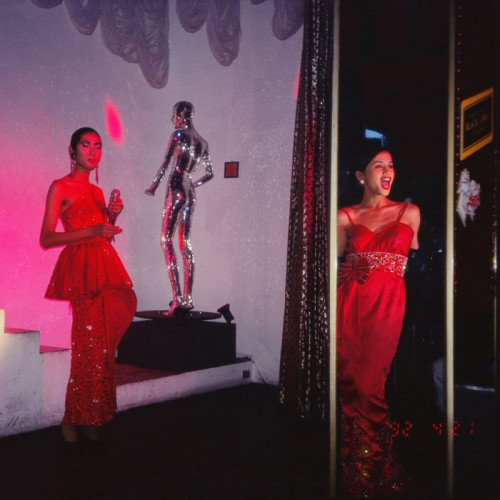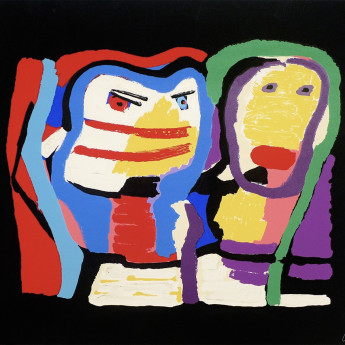Night Voices for Hidden Stories: Unlocking the Marginal Root of Queer Art

By Andrew Bay, UK
Queer aesthetics emerged as a transformative movement, created by LGBTQ+ individuals and communities, which have shattered the staid conventions of visual and cultural forms of expression, in our modern societies. With a wild fury of political and social activism, the impact of Queer aesthetics on the art world can no longer be denied, as it has resolutely and bravely challenged traditional norms and values, regarding gender and sexuality throughout our recent history. The works of influential artists such as Francis Bacon and Robert Mapplethorpe, with their unflinching portrayals of gender and sexuality, are considered key landmarks in the development of queer aesthetics. They ushered in a new era of artistic expression and in doing so, shook the establishment, polite society and conventional norms to their core.
Bacon's art is characterized by its fascinatingly twisted journey through the human psyche and its grotesque yet intimate portrayals of bodily figures. Mapplethorpe's photography on the other hand, controversially explores masculine nudity with provocative flair, deliberately creating controversy with the explicit nature of his work. A new generation of queer artists, following in the footsteps of these pioneering trailblazers, continued to turn heads. American photographer Nan Goldin, British artist Grayson Perry, and American sculptor Glenn Ligon are still pushing boundaries and contributing to the development of queer aesthetics, by exploring the complex nuances of gender and sexuality in fresh, new ways.
Queer aesthetics is also characterized by its use of camp humour and irony, to challenge gender binary definitions and values. It served as a crucial means of social and political activism, by bringing considerable awareness to the AIDS epidemic through the ACT UP organisation in the 1980s and 90s. They used art as a political tool to demand urgent healthcare action from the government. Keith Haring, an openly gay artist, created during that time, works that addressed the LGBTQ community's imminent concerns and its valiant struggle against the epidemic. Although he wasn’t an artist per se, Harvey Milk, was a key gay rights activist and politician, who, upon being elected as a City Councillor to the mayor of San Francisco, was tragically murdered in 1978, for his sexual orientation. His legacy still inspires a new generation of queer artists such as Chuck Sperry, Gus Bean, and George Segal. Over the years, they have collectively created memorable artworks, screen prints, mosaics and sculptures, in honour of the late politician.
On the other side of the North American continent, the House and Ballroom Scene of New York City is a vibrant subculture that has been pushing boundaries and shaking up the status quo for decades. At the heart of this scene are wild, strutting drag queens and performers, who have been honing their craft to perfection, taking the art of drag to dizzying new heights. This world is not for the faint of heart, but if you're ready to let your head spin, these live performers will welcome you with open arms.
Through their art and compelling live shows, the drag queens of the House and Ballroom Scene have played a major role in advancing the visibility and acceptance of LGBTQ+ individuals, an issue which is still of the utmost importance in our time. They have skilfully used their platform to draw attention to the struggles and triumphs of the queer community, and to celebrate their strength and fortitude. The legendary performances of Ru Paul and Lady Bunny, and the ground breaking displays of contemporary performers like Sasha Velour and Aquaria, have consistently expanded and redefined the possibilities of drag as an art form. The impact of these artists’ innovations on popular culture cannot be understated. They have inspired countless individuals to seek for their true selves and to reject the social conventions which had hitherto attempted to define them. Queer aesthetics most significant contribution to our culture has been as a creative tool for social change. Its genuine power still resides in its boundless capacity to challenge, inspire and uplift the human experience.
By Andrew Bay, UK
Queer aesthetics emerged as a transformative movement, created by LGBTQ+ individuals and communities, which have shattered the staid conventions of visual and cultural forms of expression, in our modern societies. With a wild fury of political and social activism, the impact of Queer aesthetics on the art world can no longer be denied, as it has resolutely and bravely challenged traditional norms and values, regarding gender and sexuality throughout our recent history. The works of influential artists such as Francis Bacon and Robert Mapplethorpe, with their unflinching portrayals of gender and sexuality, are considered key landmarks in the development of queer aesthetics. They ushered in a new era of artistic expression and in doing so, shook the establishment, polite society and conventional norms to their core.
Bacon's art is characterized by its fascinatingly twisted journey through the human psyche and its grotesque yet intimate portrayals of bodily figures. Mapplethorpe's photography on the other hand, controversially explores masculine nudity with provocative flair, deliberately creating controversy with the explicit nature of his work. A new generation of queer artists, following in the footsteps of these pioneering trailblazers, continued to turn heads. American photographer Nan Goldin, British artist Grayson Perry, and American sculptor Glenn Ligon are still pushing boundaries and contributing to the development of queer aesthetics, by exploring the complex nuances of gender and sexuality in fresh, new ways.
Queer aesthetics is also characterized by its use of camp humour and irony, to challenge gender binary definitions and values. It served as a crucial means of social and political activism, by bringing considerable awareness to the AIDS epidemic through the ACT UP organisation in the 1980s and 90s. They used art as a political tool to demand urgent healthcare action from the government. Keith Haring, an openly gay artist, created during that time, works that addressed the LGBTQ community's imminent concerns and its valiant struggle against the epidemic. Although he wasn’t an artist per se, Harvey Milk, was a key gay rights activist and politician, who, upon being elected as a City Councillor to the mayor of San Francisco, was tragically murdered in 1978, for his sexual orientation. His legacy still inspires a new generation of queer artists such as Chuck Sperry, Gus Bean, and George Segal. Over the years, they have collectively created memorable artworks, screen prints, mosaics and sculptures, in honour of the late politician.
On the other side of the North American continent, the House and Ballroom Scene of New York City is a vibrant subculture that has been pushing boundaries and shaking up the status quo for decades. At the heart of this scene are wild, strutting drag queens and performers, who have been honing their craft to perfection, taking the art of drag to dizzying new heights. This world is not for the faint of heart, but if you're ready to let your head spin, these live performers will welcome you with open arms.

















